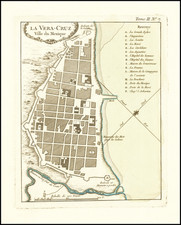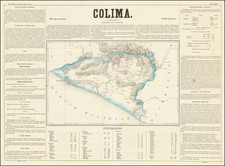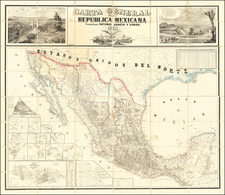Crossing from Atlantic to Pacific Before the Panama Canal
Rare map of the southern portion of the Isthmus of Tehuantepec, which was considered a possible location for a pathway from Atlantic to Pacific in the mid-nineteenth century.
The isthmus is sandwiched between the Gulf of Campeche to the north and the Gulf of Tehuantepec in the south. It is only 137 miles wide and it is only 120 miles from the Atlantic to Laguna Superior.
Laguna Superior is a major feature of this map, which focuses on the southerly reaches of the isthmus. It is accompanied in the lower portion of the document by a vertical profile showing the altitude and obstructions in the terrain of the proposed route.
The map is very detailed, with settlements, roads, rivers, and hills minutely drawn. This area was subjected to a trigonometric survey as part of the preparation for a possible route across the isthmus; the legend includes symbols for the primary, secondary, and tertiary measurement points, as well as locations where latitude and longitude were calculated.
The survey underlying this map was undertaken by Don José de Garay between 1842 and 1843. Thanks to the huge growth in international maritime trade brought on by global empires and steam ship technology, many businesses and governments were in need of the fastest shipping routes by the mid-nineteenth century. One of the most likely places for a route that would eliminate the time-intensive and dangerous navigation around Cape Horn was the Isthmus of Tehuantepec.
Garay was granted a swath of land by General Santa Anna, the leader of Mexico, to develop a canal across the isthmus. A condition of the grant, however, was that Garay conduct a survey. Garay did so, completing his work in February 1843. Garay then commenced work using convict labor.
The political upheaval of the time, which included the Mexican-American War, meant that the work was continually delayed. In addition, Garay passed the contract to a pair of British businessmen, and they to the Hargous brothers of New York. Discussion as to the United States’ role in the project stretched out over several years. Meanwhile, the work languished and eventually was abandoned.
Even after the idea of a canal was abandoned as too costly, the idea of some sort of route across the isthmus lingered. The US proposed a huge four-track railway that could transport massive ocean liners and cargo ships. After some design changes and many stops-and-starts, the Tehuantepec Railway opened in January 1907.









![Amer. Sep. No. 70. Partie Du Mexique [Acapulco]](https://storage.googleapis.com/raremaps/img/small/96401.jpg)
![Mapa et tierra q[u]e yos pedro Vial taigo transitau en St. Tafee este dia 18 de Octubre de La ao 1787](https://storage.googleapis.com/raremaps/img/small/3645.jpg)



![(Mexican-Aztec Paintings) [Original watercolor of 4 Aztec Festival Deities]: Veitecuilitl, Miccailhhuitl, Festival of the Dead, Veymiccailhuitl, Ochpaniztl](https://storage.googleapis.com/raremaps/img/small/103004.jpg)